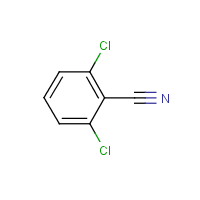Dichlobenil
Agent Name
Dichlobenil
CAS Number
1194-65-6
Formula
C7-H3-Cl2-N
Major Category
Pesticides

Synonyms
Casoron; Dyclomec; Barrier; [EPA Pesticides] 2,6-DBN; 2,6-Dichlorbenzonitril [German]; 2,6-Dichlorobenzonitrile; 2,6-Dichlorophenyl cyanide; Benzonitrile, 2,6-dichloro-; Casoron 133; Casoron G-10; Casoron G-4; Casoron G20 SR; Casoron W-50; Casoron gsr; Code H 133; Cyclomec; DBN; DBN (pesticide); DBN (the herbicide); DU-Sprex; Decabane; H 133; NIA 5996; Niagara 5,996; Norosac; Prefix D; Surfassol; Benzonitrile, 2,6-dichloro-; [ChemIDplus]
Category
Herbicides, Nitrile
Description
White to off-white solid; [ICSC] White solid; Formulated as granular, ready-to-use liquid, soluble concentrate, and wettable powder; [Reference #1] Light grey powder; [Aldrich MSDS]
Sources/Uses
Used as herbicide for cranberry bogs, orchards, vineyards, berry fields, ornamentals, nurseries, public easements, industrial areas, railroads, and sewers; Also used as a preservative (adhesives and industrial); [HSDB] Casoron G (67.5% active ingredient): Ready-to-use granular formulation used in the EU for weed control in vineyards; [EFSA]
Comments
A nitrile herbicide; [Hayes, p. 771] Listed as potential inducer of chloracne; [Rosenstock, p. 714] According to "Recognition and Management of Pesticide Poisonings," it has an acute LD50 of greater than 4,460 mg/kg and has "minimal toxic, irritant effects." [EPA Pesticides, p. 119] A major metabolite of the herbicide chlorthiamid; Can be absorbed through skin; May cause chloracne; [ICSC] Reports of chloracne in a manufacturing facility; [HSDB] Causes hepatitis in animal experiments; [Reference #1]
Reference Link #1
Biomedical References
Exposure Assessment
Bioaccumulates
Yes
Vapor Pressure
0.00101 mm Hg
Lethal Concentration
LC50 (rat) > 3,300 mg/m3
Explanatory Notes
VP = 6.6X10-4 mm Hg at 20 deg C; [HSDB]
Adverse Effects
Hepatotoxin
Hepatoxic (a) from occupational exposure (secondary effect) or (b) in animal studies or in humans after ingestion
Dermatotoxin
Chloracne
Diseases, Processes, and Activities Linked to This Agent
Diseases
Occupational diseases associated with exposure to this agent:
Processes
Industrial Processes with risk of exposure: